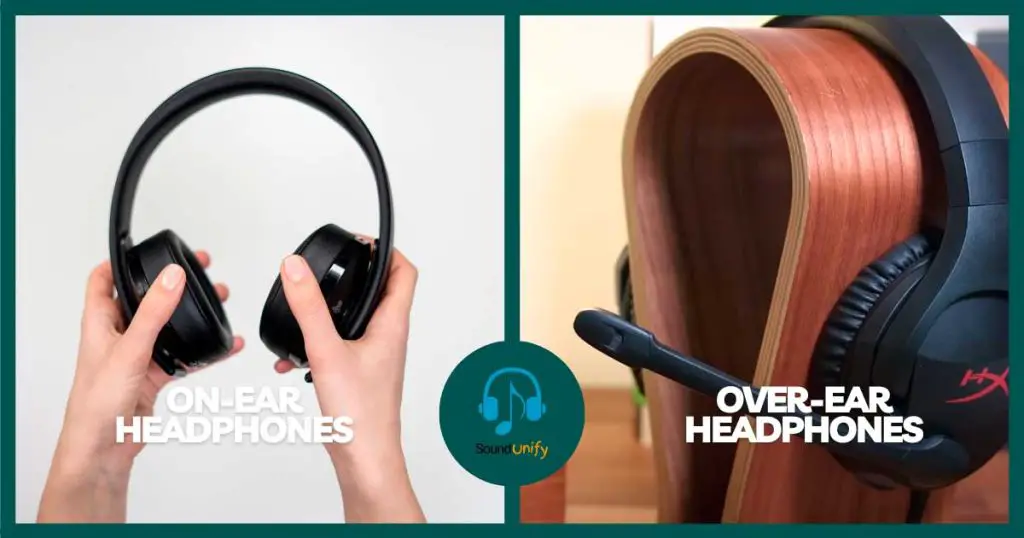On-ear headphones sit on top of your ears rather than over them. This design allows sound to pass through unimpeded, resulting in a more immersive audio experience.
Additionally, on-ear headphones typically provide a better bass response and noise cancellation than other headphones. So, if you want headphones that make your music sound amazing, on-ear headphones are a great choice.
What Are On-Ear Headphones
For the comfort and convenience of listening to music, on-ear headphones have replaced over-ear headphones. On-ear headphones rest on your ears, and in some cases, they also have a small ear cushion, further improving comfort.
On-ear headphones are smaller and lighter in weight than over-ear headphones, making them easy to transport with you. Ambient noise is still audible to a small extent, which is why on-ears are safest in traffic.
On-ear headphones are generally more comfortable because they rest on the ears instead of around them. So users don’t feel suffocated at all.
On-Ear vs. Over-Ear Headphones: What’s the Difference?

On-ear headphones are a great option whether a music lover or an on-the-go person. They can offer better sound quality to listen to music privately at home or in quiet surroundings. On-ear headphones are the perfect choice whether you’re on your way to work or on an outing. Those have some unique features that are worth discussing.
1. Features
On-ear headphones have some unique features. They have on-ear cups designed to fit in your ear canal.
So, when you put on the headphones and wear them, over-the-ear headphones will be bulky and not comfortable in this area.
Another unique feature of on-ear headphones is their small ear cushion. This ear cushion makes wearing noise-canceling headphones much more comfortable than over-ear models.
It further improves sound quality by isolating outside noise from leaking, meaning you can concentrate on the music.
2. Sound
On-ear headphones deliver superior sound quality to over-ear headphones in almost every way. Over-ear headphones often have an excessive bass response and are not as clear regarding mids and highs.
On-ear headphones also provide a better listening experience because they allow you to move freely without worrying about damaging your audio equipment.
3. Comfortability
Over-ear headphones are generally more comfortable but can be bulky and obstruct your view.
While on-ear headphones are not as comfortable because of their smaller earcups, since the manufacturer made many changes in the earcups and cushions, they are comfortable to wear.
4. Stability
On-ear headphones are more stable than other headphones as they
- Pivot on the ear cups
- Have a headband that securely holds headphones in place
- They are lightweight, so they do not obstruct your movement.
5. Battery Life
Headphones with on-ear earbuds have shorter cord lengths and, thus, offer a longer battery life. In comparison, over-ear headphones have larger cord lengths, so their battery life is shorter.
While on-ear headphones are usually better for music listening because of the immersive sound they produce, over-ear headphones are better for general audio use as they provide superior noise cancellation abilities and sound isolation.
6. Portability
Over-ear headphones are more portable as they fit over the ear and are thus less bulky. On the other hand, on-ear headphones are generally more comfortable to wear as they sit on your ear as earphones do. You can fold the headphone and take them to your backpack.
7. Size
These are generally smaller and do not require a different box to carry them out. Due to compact hardware, on-ear headphones can be folded and stored inside your backpack.
8. Travel
On-ear headphones are better if you want to hear what’s happening around you while simultaneously listening to your favorite music.
Because of their compact design and lightweight, you may easily stow them in a handbag or backpack. Alternatively, wear them around your neck and be ready to go.
9. Price
On-ear headphones are less expensive comparatively over-ear headphones. You can choose them at your desired price from their vast price range as they come in different sizes and quality.
| Criteria | On-ear headphones | Over-ear headphones |
| Weight | Light-weight and portable | More weight than on-ear |
| Noise isolation | Don’t provide as much noise isolation as over-ear. | It provides better noise isolation. |
| Price | Generally, less expensive | More expensive than on-ear |
| Ear cups | Smaller and sits on the ear. | Bigger and surround the ear |
| Comfort level | Less comfortable for long-term wear. | More comfortable than on-ear. |
| Leak sound | More likely to leak sound to the surroundings than over-ear. | Don’t leak sound and gives better noise cancellation. |
What Are the Benefits of On-Ear Headphones?
Headphones are a crucial part of any audio equipment kit. They are perfect for daily use – at home or on a busy street – as they keep you focused and away from distractions.
Hence, those have some pros and cons that are given below.
Pros
- They have larger drivers than in-ear.
- Don’t cover your entire ear, so they don’t make your ears as hot.
- Typically, they are lighter and more comfortable than over-ear headphones.
- Firmer than over-ear.
- Larger sound stage than in-ear.
- Usually less expensive than over-ear headphones.
- More portable and take up less space.
- They cause fewer headaches or ear fatigue.
- Don’t block out all outside noise, so you can still hear your surroundings.
- You can wear it for long periods without causing discomfort.
Cons
- Have more head buildup than in-ear.
- It can leak sound and disturb others around you.
- It has smaller drivers than over-ear.
- A little less comfortable than over-ear or in-ear
- Easy to lose or misplace.
- It can be a breeding ground for bacteria and other germs.
FAQs
Q. Is it safe to wear earphones while exercising?
Generally, it is safe to wear earphones while exercising. This is because earphones offer a sense of peace and privacy while working out and better sound quality. Additionally, ensure that the headphones you buy fit snugly in your ears with minimal noise leakage.
Q. How can I best use on-ear headphones for my listening experience?
On-ear headphones are designed to sit on top of your ears and provide a more immersive listening experience than earbuds. Here are a few tips to get the most out of your on-ear headphones:
Adjust the fit. You can adjust on-ear headphones to fit your ears snugly, which will help you block out external noise and focus on your music.
Use EQ settings. Many on-ear headphones have built-in EQ settings that let you customize the sound to your liking. Experiment with different settings to find out what sounds best to you.
Consider noise-canceling. If you’re looking for an even more immersive experience, look for on-ear headphones with noise-canceling capabilities. This feature will help you block out even more external noise so that you can focus on your music.
Q. Why Do On-Ear Headphones Hurt My Ears?
On-ear headphones can hurt your ears for a few reasons. They put pressure on your ear’s delicate skin and can trap heat and sweat against your ear, which can lead to irritation. If you’re using on-ear headphones, take breaks often and give your ears a chance to rest.
Q. Are On-ear Headphones Uncomfortable?
Most people don’t think so – most of them find them quite comfortable. They offer an immersive listening experience and are perfect for runners, cyclists, and other athletes who want to stay focused on their audio source. They are much lighter than over-ear headphones and easier to carry around.
But they can be uncomfortable if they are not a good fit. If the headphones are too big or too small, they can cause discomfort. Additionally, if the ear cups are not padded well, they can cause discomfort.
Final Verdict
On-ear headphones are perfect for those who want a sound closer to their ear and offer an immersive experience. However, they may be uncomfortable if the headphones do not fit well or if the ear cups aren’t padded well.
James Dimento is a Chief-in-Editor of SoundUnify. He is a headphone enthusiast and creative writer passionate about audio technology. He has three years of experience writing about headphones and sound quality and is responsible for creating reviews and taking care of all administration.
